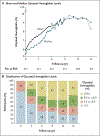Long-Term Complications in Youth-Onset Type 2 Diabetes
- PMID: 34320286
- PMCID: PMC8697255
- DOI: 10.1056/NEJMoa2100165
Long-Term Complications in Youth-Onset Type 2 Diabetes
Abstract
Background: The prevalence of type 2 diabetes in youth is increasing, but little is known regarding the occurrence of related complications as these youths transition to adulthood.
Methods: We previously conducted a multicenter clinical trial (from 2004 to 2011) to evaluate the effects of one of three treatments (metformin, metformin plus rosiglitazone, or metformin plus an intensive lifestyle intervention) on the time to loss of glycemic control in participants who had onset of type 2 diabetes in youth. After completion of the trial, participants were transitioned to metformin with or without insulin and were enrolled in an observational follow-up study (performed from 2011 to 2020), which was conducted in two phases; the results of this follow-up study are reported here. Assessments for diabetic kidney disease, hypertension, dyslipidemia, and nerve disease were performed annually, and assessments for retinal disease were performed twice. Complications related to diabetes identified outside the study were confirmed and adjudicated.
Results: At the end of the second phase of the follow-up study (January 2020), the mean (±SD) age of the 500 participants who were included in the analyses was 26.4±2.8 years, and the mean time since the diagnosis of diabetes was 13.3±1.8 years. The cumulative incidence of hypertension was 67.5%, the incidence of dyslipidemia was 51.6%, the incidence of diabetic kidney disease was 54.8%, and the incidence of nerve disease was 32.4%. The prevalence of retinal disease, including more advanced stages, was 13.7% in the period from 2010 to 2011 and 51.0% in the period from 2017 to 2018. At least one complication occurred in 60.1% of the participants, and at least two complications occurred in 28.4%. Risk factors for the development of complications included minority race or ethnic group, hyperglycemia, hypertension, and dyslipidemia. No adverse events were recorded during follow-up.
Conclusions: Among participants who had onset of type 2 diabetes in youth, the risk of complications, including microvascular complications, increased steadily over time and affected most participants by the time of young adulthood. Complications were more common among participants of minority race and ethnic group and among those with hyperglycemia, hypertension, and dyslipidemia. (Funded by the National Institute of Diabetes and Digestive and Kidney Diseases and others; ClinicalTrials.gov numbers, NCT01364350 and NCT02310724.).
Copyright © 2021 Massachusetts Medical Society.
Figures


Comment in
-
Long-Term Complications in Youth-Onset Type 2 Diabetes.N Engl J Med. 2021 Nov 18;385(21):2014-2015. doi: 10.1056/NEJMc2114053. N Engl J Med. 2021. PMID: 34788518 No abstract available.
-
Long-Term Complications in Youth-Onset Type 2 Diabetes.N Engl J Med. 2021 Nov 18;385(21):2015. doi: 10.1056/NEJMc2114053. N Engl J Med. 2021. PMID: 34788519 No abstract available.
References
-
- Al-Saeed AH, Constantino MI, Molyneaux L, et al. An inverse relationship between age of type 2 diabetes onset and complication risk and mortality: the impact of youth-onset type 2 diabetes. Diabetes Care 2016; 39: 823–9. - PubMed
Publication types
MeSH terms
Substances
Associated data
Grants and funding
- U01-DK61230/DK/NIDDK NIH HHS/United States
- M01 RR000036/RR/NCRR NIH HHS/United States
- M01-RR00084/RR/NCRR NIH HHS/United States
- U01 DK061212/DK/NIDDK NIH HHS/United States
- M01 RR014467/RR/NCRR NIH HHS/United States
- U01 DK061230/DK/NIDDK NIH HHS/United States
- M01-RR00125/RR/NCRR NIH HHS/United States
- M01 RR000084/RR/NCRR NIH HHS/United States
- M01-RR00036/RR/NCRR NIH HHS/United States
- UL1-RR024134/RR/NCRR NIH HHS/United States
- UL1 TR002345/TR/NCATS NIH HHS/United States
- U01-DK61212/DK/NIDDK NIH HHS/United States
- U01 DK061254/DK/NIDDK NIH HHS/United States
- UL1 RR024139/RR/NCRR NIH HHS/United States
- UL1 RR024989/RR/NCRR NIH HHS/United States
- M01-RR01066/RR/NCRR NIH HHS/United States
- P30 DK048520/DK/NIDDK NIH HHS/United States
- M01-RR00043-45/RR/NCRR NIH HHS/United States
- UL1 TR002548/TR/NCATS NIH HHS/United States
- UL1 RR024153/RR/NCRR NIH HHS/United States
- UL1-RR025758/RR/NCRR NIH HHS/United States
- UL1-RR024992/RR/NCRR NIH HHS/United States
- UL1 TR001857/TR/NCATS NIH HHS/United States
- M01-RR00069/RR/NCRR NIH HHS/United States
- UL1 TR001863/TR/NCATS NIH HHS/United States
- UL1 RR025780/RR/NCRR NIH HHS/United States
- UL1-RR024989/RR/NCRR NIH HHS/United States
- UL1-RR025780/RR/NCRR NIH HHS/United States
- U01-DK61242/DK/NIDDK NIH HHS/United States
- M01 RR000069/RR/NCRR NIH HHS/United States
- UL1 TR002535/TR/NCATS NIH HHS/United States
- U01-DK61254/DK/NIDDK NIH HHS/United States
- M01-RR14467/RR/NCRR NIH HHS/United States
- U01 DK061242/DK/NIDDK NIH HHS/United States
- R01 DK111038/DK/NIDDK NIH HHS/United States
- UL1 RR024992/RR/NCRR NIH HHS/United States
- M01 RR001066/RR/NCRR NIH HHS/United States
- UL1 TR000003/TR/NCATS NIH HHS/United States
- UL1-RR024139/RR/NCRR NIH HHS/United States
- M01 RR000043/RR/NCRR NIH HHS/United States
- U01-DK61239/DK/NIDDK NIH HHS/United States
- K24 HL145076/HL/NHLBI NIH HHS/United States
- UL1-RR024153/RR/NCRR NIH HHS/United States
- UL1 RR025758/RR/NCRR NIH HHS/United States
- M01 RR000125/RR/NCRR NIH HHS/United States
- U01 DK061239/DK/NIDDK NIH HHS/United States
- UL1 RR024134/RR/NCRR NIH HHS/United States
LinkOut - more resources
Full Text Sources
Other Literature Sources
Medical
